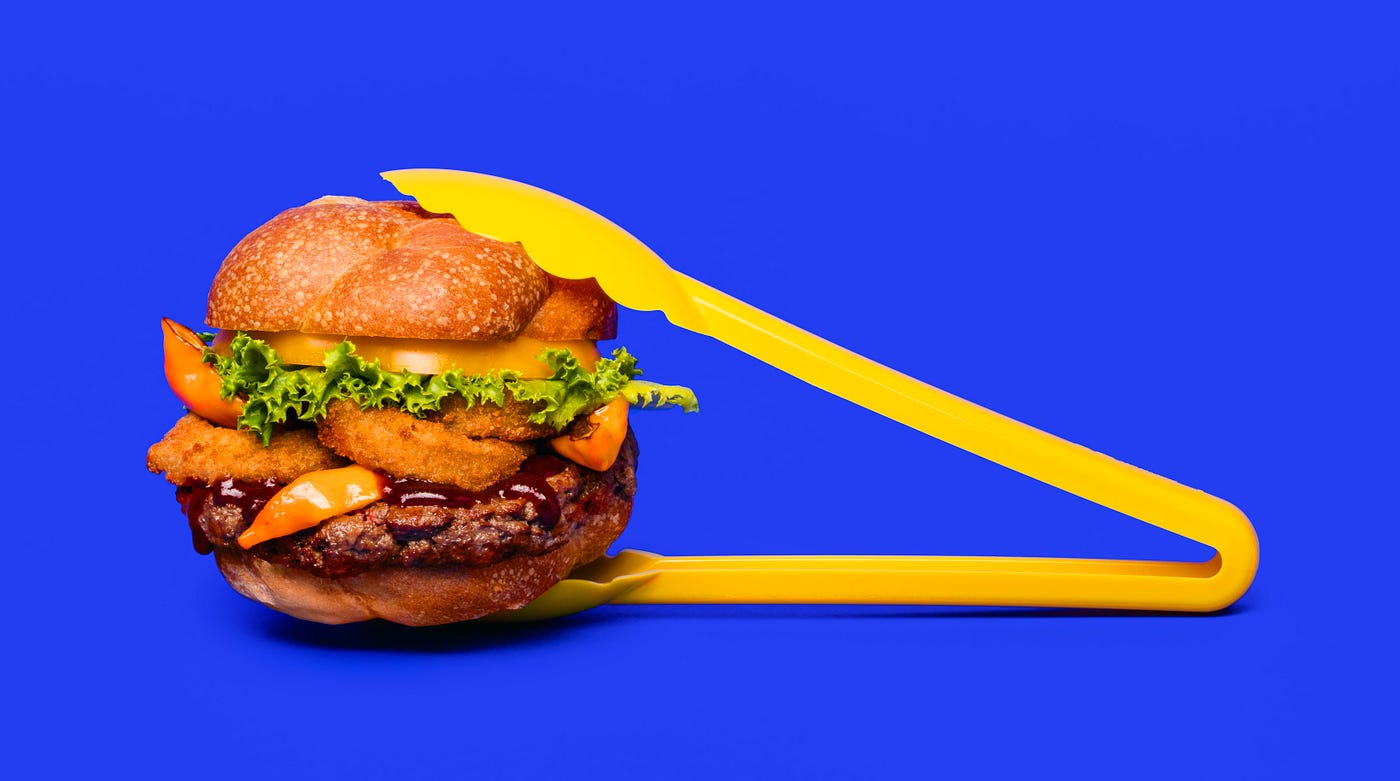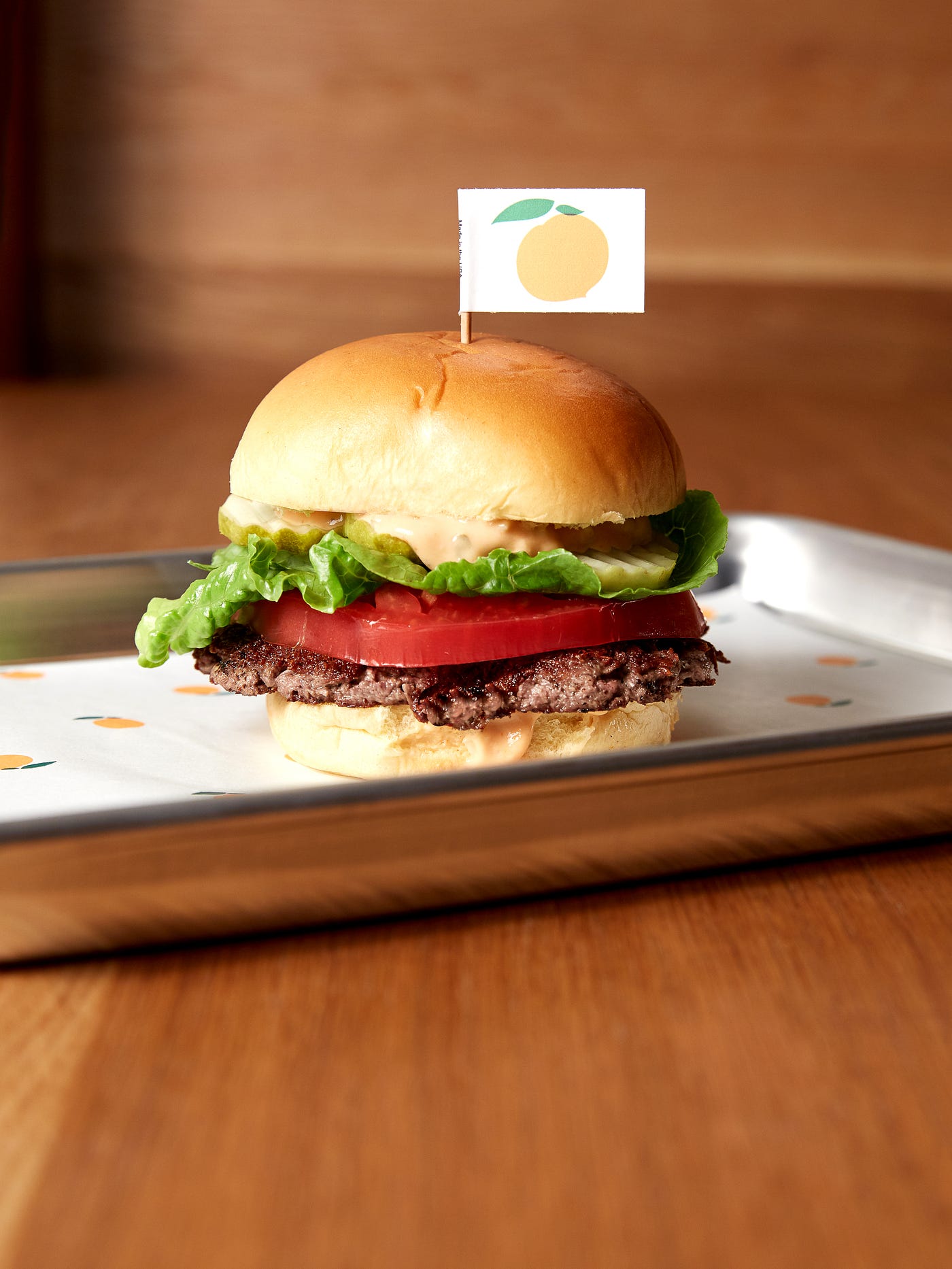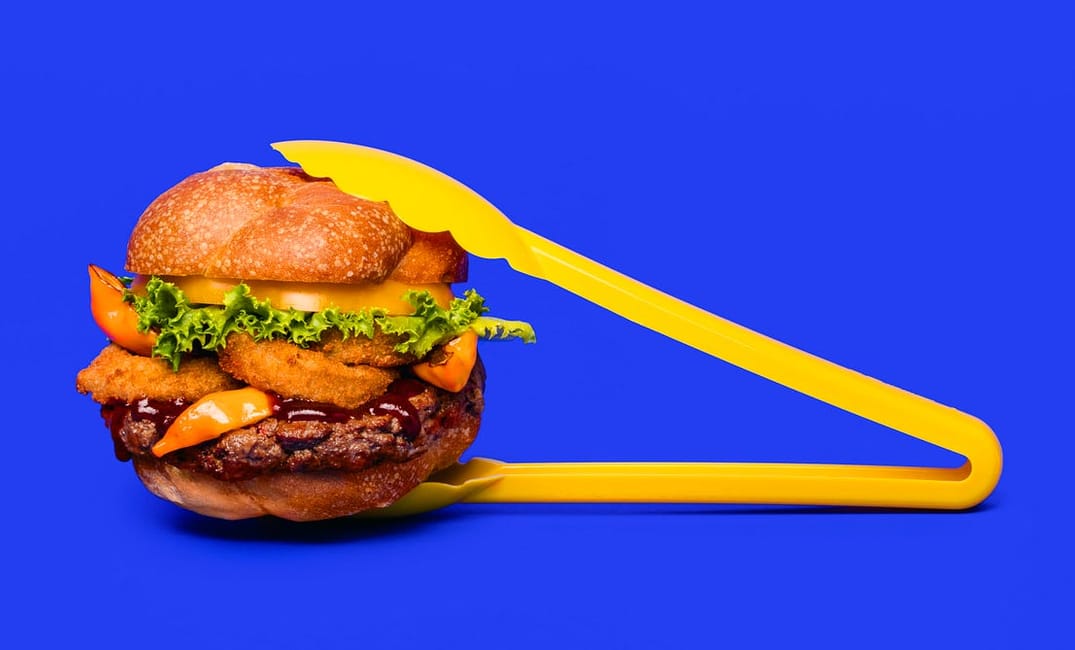
It felt like the colorful balloons, raucous music and copious booze were all for me. In reality, it was KronnerBurger’s two-year-anniversary celebration and had nothing to do with the excitement I was feeling walking into the Piedmont-neighborhood restaurant for the first time, ready to taste the future.
A self-described “Oakland Burger paradise,” KronnerBurger is a temple to the art of the burger. They serve hamburgers along with other choice items that go with hamburgers (wedge salads, onion rings, etc.). They have been lauded as one of the best burger joints in country.
If I were someone who still ate burgers, I surely would have checked the place out sooner. Back in the day, I loved me some burgers. So why was my vegetarian self so giddy about KronnerBurger? Because after years of anticipation, I was finally going to try the Impossible Burger.
Surely you have heard of the Impossible Burger? This high-tech marvel is the marquee product of Impossible Foods and is touted as a potential game changer for how the world eats.

The Tesla of food
Hype-wise, the Impossible Burger is nothing less than the Tesla of food, a product intended to disrupt an entire industry while saving the world at the same time. Impossible Foods, the company behind the burger, is on a quest to manufacture plant-based meats that taste so much like the real thing that we may all stop eating animals. As its founder, Pat Brown, puts it, their mission is to “replace animals globally with a system to make more nutritious, healthier foods for the world.” Vegetarians are not their target market. This is about winning over the carnivores.
This Fremont-based company and their scientifically intensive burger have received a ton of press due to their audacious vision of creating veggie meat that’s indistinguishable from animal meat. Impossible Foods is currently developing chicken, pork, fish and yogurt that are all made from plant-based ingredients, but the only product that’s currently available for public consumption is their ground-beef patty. And the only place to get it is at a handful of restaurants in NYC, LA and the Bay Area.
I personally had not met anyone who had tried the Impossible Burger, but I’ve been living vicariously through dozens of articles and podcasts over the last two years in the buildup to this momentous occasion.
Heme meme
What sets Impossible Burger apart from other faux-meat contenders is a genetically modified protein called “heme,” isolated from soy, that is also found in animal blood. Heme is what makes blood red and is one of the unmistakable trademarks of what makes meat look and taste like meat. So the Impossible Burger is not just meaty; it’s bloody.
Everything I’ve read about the Impossible Burger has been overwhelmingly positive. Hard-core meat lovers have said they can’t tell the difference. Reviewers can’t seem to gush enough platitudes about them. The founder’s TED talk is inspiring as all heck. But tasting is believing, and after all the hype, it was finally time for me to experience the future for myself.
Impossible Foods is currently building an Impossible Burger gigafactory (of sorts) in Oakland, which means that in the near future, they’ll be available widely at supermarkets and restaurants. Impossible Foods’ clever marketing strategy has been to let a handful of renowned chefs get creative and serve it up in their restaurants. KronnerBurger is still the only spot in the East Bay where you can try it. Their take on the Impossible Burger hit their menu in March. I held my breath and gave them a few months to figure out how to cook the thing.

Überburger
I made the pilgrimage with my wife and another couple, a merry foursome of two meat eaters and two vegetarians. My friend got the eponymous KronnerBurger, which the restaurant serves rare. And by “rare,” I mean it looked like they had taken a patty of fresh ground beef, microwaved it for 10 seconds and slapped it on a bun—E. coli be damned. By all accounts, it was a fantastic-looking burger. My wife tried to order the same thing, though being pregnant, she asked them to actually cook it just to be safe. Generally speaking, restaurants accommodate pregnant ladies, but the waitress was quick to disabuse her of any special status within these hallowed walls of burger sanctity. “They will only serve it rare,” she snarled.
I admire this sort of severe food purism. One could certainly go down the street to Barney’s and procure a fine burger for less money, cooked exactly how one wants it. But what fun is that? All this added to my excitement that the KronnerBurger küchenchefs would be equally severe in their treatment of my Impossible Burger, which was now sitting in front of me, minimally adorned in mayo, lettuce, grilled onions, dill pickle and cheddar cheese — on a pain de mie bun — which must mean “hamburger bun” in French, because that’s what it looked like. A bold move that they didn’t smother it in mushrooms or other such yummy accoutrements to mask the true character of the protein, the star of the show—this was about tasting and experiencing the future of meat.
Now before we sink our teeth into this thing, we have to mention the price. It’s expensive. The burger costs $19, plus $2 for the cheese. And that’s with no fries or even a smidgeon of side slaw, which, under any other circumstance, would be a crime. But in this case, the price was less about food and more like getting tickets to a special exhibit at a museum. Eventually, Impossible Meats will be cheaper than meat meat, but for now it’s a scarce commodity, and you have to be willing to shell out. At the very least (since I’m writing about it now), that $21 burger will be a tax write-off. But it still seems crazy that I could buy four burritos instead of this one burger.
Tasting the future
All right … let’s eat. At first whiff, true burger aroma. There is nothing else in the world that smells like a burger—except for whatever the heck it is I’m about to eat. The meat is perfectly textured and seared with carbony, crusty goodness. It looks like a perfectly grilled burger! So far, so good. Before shoving it into my mouth, I rip off little bits of meat for visual examination. I think most meat aficionados could tell the difference between the Impossible Meat molecules and real meat protein. But then again, not all meat is ground to the same grain, and I have extremely good eyesight. So maybe not. I’m confident that no one would notice any discrepancy unless they were in full-blown scrutiny mode.
Upon my first bite, I immediately knew three things:
- It tastes like meat.
- It’s salty!
- I do not believe I am eating the future.

Don’t believe the hype
The Impossible Burger is a technological marvel. There’s nothing about it that would tip off an eater to the fact that it’s plant based. It’s bloody and juicy, and I had to be mindful to pace myself, chew slowly and not wolf the whole thing down in 45 seconds.I’m suspicious of how salty it is. They probably have to ramp up the sodium to cover up something funky. I hope they can fix that, but once you’re a few bites in, the other taste layers ease into the forefront.
All that being said, I wouldn’t order it again, and I don’t think it’s going to convince droves of meat eaters to make the switch.
Most folks still think of food simply as food and don’t engage with what they eat as a complex matrix of environmental/ethical/social/health issues.Trapped in our Oaklandivore bubble, it’s hard to remember that everyone on Earth isn’t as obsessed with artisanal food culture like we are here. Price, taste and quality are what most consumers seek at the supermarket. For Impossible Burger to do the impossible, you’ve got to imagine people all over the US going to the supermarket to grab a pound as casually as they’d buy ground beef.
I just don’t see it. I wanted to believe that we were on the cusp of this happening, but we’re not there yet. As it stands, Impossible Burger might be a precursor to the future, but not the future itself.
Yes, it tastes like meat, and in and of itself, this is an achievement. But it’s not worth freaking out about unless it has that je ne sais quoi that makes me need to eat it. What the heck is it about burgers that makes people so crazy about them? I don’t know! I’ve had so many memorable burgers in my life and also fantastic veggie burgers that made me feel that way. Impossible Burger? Not so much. I’m fine with never having one again.
The Tofurkey anathema
My hope is that the mad scientists at Impossible Foods will not rest until they get it right. When they do go mass market, it has to be because they’ve perfected their product and not that they’re riding the media hype machine and trying to appease investors. If it’s anything less than that, it’ll be like when the first Tofurkeys hit the market in the ’90s. The much maligned Tofurkey became symbolic of the folly of tree huggers and hippie-dippies. And while the fake-meat section in the supermarket has come a long way since then, people still joke about Tofurkey as shorthand for snarking on all things vegetarian.
In terms of public relations, the original Tofurkey is still a disaster. With all the hype surrounding Impossible Burger, there’s a risk of that happening again. An underwhelming taste left in people’s mouths will make it that much harder to penetrate the market, if and when a company finally does perfect their recipe. People will be intrigued to give it a shot…once. If it’s not new love at first bite, who would come back for a second bite when their first love is right there waiting for them?
All photos courtesy of Impossible Foods.







